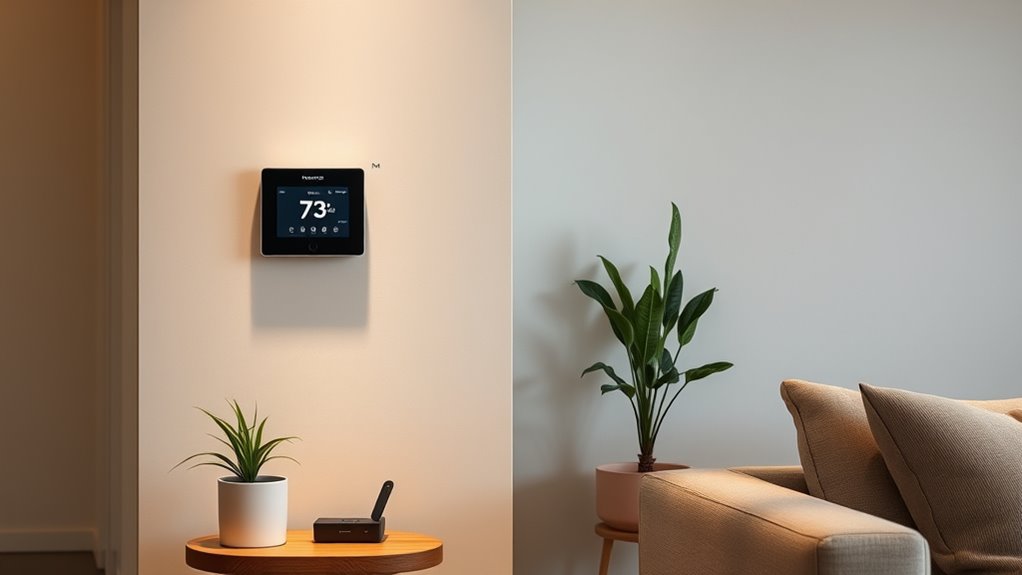If you’re looking for the best smart thermostats with remote sensors, I recommend models like ecobee Smart Thermostat Premium, Honeywell T9, and Google Nest that offer precise temperature control across multiple rooms. These systems include sensors to detect occupancy and conditions, helping save energy and boost comfort. Compatibility with voice assistants and easy installation are key features. Keep exploring, and I’ll share detailed insights so you can choose the perfect setup for your home.
Key Takeaways
- Many top smart thermostats, like ecobee and Honeywell T9, support remote sensors for precise room-specific climate control.
- Compatibility with various HVAC systems and Wi-Fi protocols ensures seamless integration with smart home setups.
- Features like occupancy detection, multi-room management, and air quality monitoring optimize comfort and energy efficiency.
- User-friendly apps and voice control enable remote adjustments and scheduling for personalized home climate.
- Proper sensor placement and range are essential for achieving balanced, consistent temperatures across multiple zones.
ecobee Smart Thermostat Premium with Sensors and Air Quality Monitor
If you’re looking for a smart thermostat that delivers both energy savings and advanced air quality monitoring, the ecobee Smart Thermostat Premium is an excellent choice. It can save you up to 26% annually on heating and cooling costs and is ENERGY STAR certified. The built-in air quality monitor alerts me to poor air conditions and offers tips for improvement, while reminding me to change filters. Its large, vibrant display and occupancy sensing make it user-friendly. Plus, the included SmartSensor ensures room-specific comfort, reducing hot and cold spots. It detects temperature drops to prevent damage, making it a thorough solution for a smarter, healthier home.
Best For: homeowners seeking a smart thermostat that combines energy efficiency, air quality monitoring, and seamless smart home integration.
Pros:
- Saves up to 26% annually on heating and cooling costs, reducing energy bills.
- Built-in air quality monitor provides real-time alerts and tips for healthier indoor air.
- Compatible with multiple smart home platforms including Apple, Alexa, and Google Assistant for versatile control.
Cons:
- Requires a subscription for full access to some smart security features and sensors.
- Installation may be challenging for non-technical users, especially without a C-wire.
- Premium features and sensors come at a higher price point compared to basic thermostats.
Honeywell T9 WiFi Smart Thermostat with Room Sensor
The Honeywell T9 WiFi Smart Thermostat with Room Sensor is an excellent choice for homeowners who want precise control over individual rooms’ comfort levels. Its sleek touchscreen makes navigation easy, and it works with various HVAC systems, including forced air, hot water, steam, and heat pumps with electric backup. The included Smart Room Sensors detect occupancy and temperature within 200 feet, automatically adjusting to keep specific rooms comfortable. Compatible with Alexa, Apple HomeKit, and Google Assistant, you can control it remotely via the Resideo app. Designed for easy installation, it offers energy-saving features like auto scheduling and utility program support, making it a versatile, efficient choice.
Best For: homeowners seeking precise, room-specific climate control with smart home integration and energy-saving features.
Pros:
- Compatible with multiple HVAC systems including forced air, hot water, steam, and heat pumps with electric backup
- Smart Room Sensors enable occupancy and temperature detection up to 200 feet for tailored comfort
- Supports popular voice assistants like Alexa, Apple HomeKit, and Google Assistant for remote control
Cons:
- Does not support electric baseboard heat (120-240V)
- Requires a C-wire or power adapter for most installations, which may complicate setup in some homes
- Limited to 2 AAA batteries for power, which may need replacement over time
Smart WiFi Thermostat with Room Sensor and Large Touchscreen
A smart WiFi thermostat with a room sensor and large touchscreen is an excellent choice for homeowners seeking precise temperature control and easy operation. It supports most 24VAC HVAC systems, including central air, heat pumps, boilers, and furnaces, with a quick setup via its self-test compatibility guide. The large 3.95-inch touchscreen provides clear temperature visibility, while its traditional and smart sliding touch controls make adjustments effortless for all ages. It offers 7-day scheduling and modes like Sleep, Home, and Away to optimize comfort and energy savings. Plus, reliable WiFi and Bluetooth connectivity, along with app updates, ensure seamless control and monitoring.
Best For: homeowners seeking precise, user-friendly temperature control and energy management for a variety of 24VAC HVAC systems.
Pros:
- Compatible with over 95% of 24VAC HVAC systems, including central air, heat pumps, boilers, and furnaces.
- Large 3.95-inch touchscreen for easy and clear temperature visibility and effortless adjustments.
- Supports 7-day programmable scheduling and modes like Sleep, Home, and Away for personalized comfort and energy savings.
Cons:
- WiFi only supports 2.4GHz networks, which may limit compatibility with some modern dual-band routers.
- Requires the Prodigytec app for full functionality and firmware updates, necessitating smartphone use.
- Setup may be slightly complex for users unfamiliar with smart thermostats, despite the self-test compatibility guide.
Honeywell Home Smart Room Sensor
Honeywell’s Home Smart Room Sensor is an excellent choice for homeowners seeking precise, room-specific climate control. It works with Series 3 and 4 T9/T10 Wi-Fi Smart Thermostats, sensing temperature and humidity across multiple rooms. The sensor supports motion detection, allowing it to distinguish between passing through and actual occupancy, which improves comfort. You can place it in bedrooms or other preferred spaces, either wall-mounted or tabletop, and control it easily through the Resideo app. Powered by 24V AC with two AAA batteries, installation is straightforward. Its features help tailor your home’s climate, improve sleep, and save energy effortlessly.
Best For: homeowners seeking precise, room-specific climate control that can be easily managed through a smart app and integrated with voice assistants.
Pros:
- Compatible with Series 3 and 4 T9/T10 Wi-Fi Smart Thermostats, enabling focused climate management across multiple rooms.
- Supports motion detection to distinguish between passing through and occupancy, enhancing comfort and efficiency.
- Easy DIY installation with simple app control, making it accessible for users without professional assistance.
Cons:
- Limited to use with specific Honeywell T9/T10 Wi-Fi Smart Thermostats, restricting broader compatibility.
- Requires Wi-Fi connection and app management, which may be a barrier for less tech-savvy users.
- Battery life may vary, and replacement of AAA batteries could be necessary over time.
Sensi Touch 2 Smart Thermostat with Touchscreen
For homeowners seeking precise temperature control and easy customization, the Sensi Touch 2 Smart Thermostat with Touchscreen stands out as an excellent choice. It features a vibrant color display, Wi-Fi connectivity, and a user-friendly interface. Compatible with Sensi Room Sensors (sold separately), it guarantees balanced temperatures throughout your home. It works with various HVAC systems, including air conditioners, furnaces, and heat pumps, requiring a common wire (c-wire). With support for Alexa, Google Assistant, and Samsung SmartThings, you can control it via voice or app. Easy to install and ENERGY STAR certified, it helps save on energy bills while maintaining comfort.
Best For: homeowners seeking a sleek, easy-to-install smart thermostat with customizable scheduling and voice control capabilities.
Pros:
- User-friendly touchscreen interface with vibrant color display for easy navigation
- Supports integration with popular voice assistants like Alexa, Google Assistant, and SmartThings
- ENERGY STAR certified, helping reduce energy costs through flexible scheduling and remote access
Cons:
- Requires a common wire (c-wire) for installation, which may not be available in all homes
- Sensi Room Sensors are sold separately, adding to the overall cost for room-specific temperature balancing
- Limited compatibility with HVAC systems that do not operate on 24V power or lack a C-wire
Google Nest Thermostat & Temperature Sensor (4th & 2nd Gen)
The Google Nest Thermostat (4th and 2nd Gen) stands out for those seeking precise temperature control across multiple rooms, thanks to its compatibility with additional remote sensors. I appreciate how easy it is to install, often without a C wire, and its support for most 24V systems like gas, electric, and heat pumps. The larger display with Dynamic Farsight makes it easy to see the temperature from across the room, while the ability to control it remotely via the Google Home app or voice commands adds convenience. Using sensors, I can manage hot and cold spots, ensuring consistent comfort throughout my home effortlessly.
Best For: homeowners seeking precise, energy-efficient temperature control with seamless smart home integration and multi-room comfort management.
Pros:
- Supports a wide range of 24V heating and cooling systems, including heat pumps and radiant heat.
- Larger, dynamic display with Farsight for easy visibility from across the room.
- Compatible with additional remote sensors to balance hot and cold spots in multiple rooms.
Cons:
- May require technical knowledge for optimal setup in complex HVAC systems.
- Some users might find the installation process challenging without prior experience.
- Additional sensors can increase overall cost for multi-room temperature management.
ecobee Smart Thermostat Essential – Wi-Fi Programmable Thermostat
If you want a smart thermostat that combines energy savings with easy DIY installation, the ecobee Smart Thermostat Essential is a top choice. It’s Energy Star certified, Wi-Fi-enabled, and compatible with 85% of HVAC systems, making setup straightforward—especially with the optional Power Extender Kit for homes without a C-wire. The LCD touch display and remote control via the ecobee app make managing your climate simple. It can save up to 23% annually on heating and cooling costs, thanks to smart features like schedule optimization and eco+ options. Built-in software updates guarantee it stays current, providing reliable comfort and efficiency over time.
Best For: homeowners seeking an easy-to-install, energy-efficient smart thermostat compatible with most HVAC systems and smart home platforms.
Pros:
- Supports multiple voice assistants including Siri, Alexa, Google Assistant, and Apple HomeKit for versatile control
- Easy DIY installation with optional Power Extender Kit, no batteries needed, and clear instructions
- Saves up to 23% annually on heating and cooling costs, with smart scheduling and eco+ features
Cons:
- Compatibility limited to 85% of HVAC systems; users should verify online before purchase
- Requires a Wi-Fi connection for remote features and updates, which may not be ideal in low connectivity areas
- Some advanced features and sensors are sold separately, potentially increasing overall cost
ecobee Smart Thermostat Premium 2-Pack
As someone looking to maximize energy efficiency and comfort across a larger home, the ecobee Smart Thermostat Premium 2-Pack stands out as an excellent choice. It can save up to 26% annually on heating and cooling costs and is ENERGY STAR certified for efficiency. The included SmartSensor adjusts temperatures in different rooms, reducing hot or cold spots, while the built-in air quality monitor alerts me to poor air conditions and offers helpful tips. With compatibility for Siri, Alexa, and other smart systems, plus security features like contact sensors for doors and windows, this pack provides thorough home management and comfort.
Best For: homeowners seeking to enhance energy efficiency, comfort, and home security across a larger or multi-room residence.
Pros:
- Saves up to 26% annually on heating and cooling costs, reducing energy bills.
- Includes SmartSensor and air quality monitor for personalized comfort and healthier indoor air.
- Compatible with popular smart home systems like Siri and Alexa, offering versatile control.
Cons:
- Requires a subscription for advanced security alerts and monitoring features.
- May involve installation complexity for users unfamiliar with smart thermostats and sensors.
- The 2-pack may be more costly upfront compared to single thermostat options.
Honeywell Home T9 Smart Thermostat with Room Sensor (Renewed)
For homeowners seeking precise temperature control and energy savings, the Honeywell Home T9 Smart Thermostat with Room Sensor (Renewed) stands out. You can remotely adjust the temperature via the Resideo app or voice assistants like Alexa, Google, or Apple HomeKit. Its Auto Home/Away Scheduling automatically adjusts temperatures, saving energy and reducing costs. Smart Room Sensors detect occupancy to focus comfort where needed, ensuring better sleep and overall comfort. With Honeywell’s advanced sensor technology, signals reach up to 200 feet—though range varies by home. Compatible with many heating systems, this renewed model offers smart control, energy efficiency, and personalized comfort in a sleek package.
Best For: homeowners seeking precise, energy-efficient temperature control with smart features and remote access.
Pros:
- Allows remote adjustment via mobile app or voice assistants for convenience
- Uses Smart Room Sensors to focus comfort where needed, improving sleep and overall comfort
- Auto Home/Away Scheduling helps save energy and reduce utility costs
Cons:
- Requires a C-wire for installation, which may not be available in all homes
- Not compatible with electric baseboard heating systems (120-240V)
- Signal range may vary depending on home construction, potentially affecting sensor performance
Sensi Smart Thermostat
The Sensi Smart Thermostat stands out for homeowners seeking an easy-to-install, reliable device that offers precise control without the need for a common wire in most cases. Its DIY setup includes a built-in level and step-by-step app instructions, making installation straightforward. Compatible with most residential HVAC systems, it features a sleek 5-inch LED display and supports control via buttons, voice assistants like Alexa and Google, and Wi-Fi. Energy Star certified, it helps reduce HVAC energy use by around 23%, offering remote access, scheduling, and maintenance alerts. Its dependable performance, backed by a 3-year warranty, makes it a smart choice for modern home climate management.
Best For: homeowners seeking an easy-to-install, energy-efficient smart thermostat compatible with most residential HVAC systems and voice control options.
Pros:
- DIY installation with built-in level and step-by-step app guidance simplifies setup.
- Compatible with multiple voice assistants and Wi-Fi for convenient control.
- Energy Star certified, helping to reduce HVAC energy consumption by approximately 23%.
Cons:
- May not be suitable for complex HVAC systems requiring a dedicated common wire in some cases.
- Limited to 24V AC power, which might not fit all existing setups.
- Some users may prefer more advanced features found in higher-end smart thermostats.
Google Nest Thermostat, Programmable Wi-Fi Smart Thermostat
If you’re looking to improve your home’s energy efficiency without sacrificing comfort, the Google Nest Thermostat is an excellent choice. This ENERGY STAR-certified device offers smart scheduling through the Google Home app, helping you save energy by adjusting settings when nobody’s home. It supports Wi-Fi and Bluetooth connectivity, allowing remote control from your phone, tablet, or laptop. Compatible with Google Assistant, Matter-certified voice assistants, and most smart home platforms, it’s easy to integrate. Designed to work without a C wire in most homes, it also monitors your HVAC system, sends maintenance alerts, and provides helpful energy-saving suggestions, making home climate control simple and efficient.
Best For: homeowners seeking an energy-efficient, easily programmable smart thermostat that integrates seamlessly with smart home systems and offers remote control capabilities.
Pros:
- Supports Wi-Fi and Bluetooth for flexible remote access via smartphone, tablet, or laptop
- Compatible with Google Assistant, Matter-certified voice assistants, and most smart home platforms
- Monitors HVAC system health, provides maintenance alerts, and offers energy-saving suggestions
Cons:
- Lacks a lock feature to prevent unauthorized adjustments
- Some heating-only or cooling-only systems may require additional wiring or accessories
- May require system compatibility checks with the Nest Compatibility Checker before installation
Google Nest Thermostat E Bundle
The Google Nest Thermostat E Bundle stands out as an ideal choice for homeowners seeking an easy-to-install, energy-efficient smart thermostat that learns your temperature preferences. It’s compatible with a wide range of heating systems, including boilers, heat pumps, and zoned setups. The bundle includes a Nest Temperature Sensor for precise room control, helping optimize comfort and energy savings. It uses sensor data to turn systems on or off automatically and features Home/Away Assist to save energy when you’re away. With remote control via the Nest app and voice compatibility with Alexa and Google Assistant, it offers a seamless, user-friendly experience for maintaining the perfect home climate.
Best For: homeowners looking for an easy-to-install, energy-saving smart thermostat that adapts to their preferences and integrates seamlessly with voice assistants.
Pros:
- Learns your preferred temperatures to optimize comfort and energy savings
- Compatible with a wide range of heating systems including boilers and heat pumps
- Remote control via the Nest app and voice commands for convenience
Cons:
- Installation may still require some basic technical knowledge, despite being straightforward
- Limited to heating and cooling systems that are compatible; not suitable for all HVAC setups
- Some users may find the learning feature takes time to fully adapt to their preferences
Google Nest Learning Thermostat (4th gen) + Nest Temperature Sensor (2nd gen)
For homeowners seeking precise temperature control and energy savings, the Google Nest Learning Thermostat (4th gen) paired with the Nest Temperature Sensor (2nd gen) offers an excellent solution. This sleek thermostat adapts to your schedule, learning your preferences to optimize comfort and efficiency. It works with most 24V systems and features a larger display with dynamic Farsight for easy visibility. The Nest Temperature Sensors allow you to manage hot and cold spots in different rooms, ensuring consistent comfort throughout your home. Plus, its compatibility with smart home ecosystems means you can control everything remotely via the app or voice commands, making home climate management seamless.
Best For: homeowners looking for precise temperature control, energy savings, and seamless smart home integration with easy installation and remote management.
Pros:
- Learns household patterns to optimize comfort and energy efficiency
- Large, adjustable display with dynamic Farsight for easy visibility from across rooms
- Compatible with most 24V systems and smart home ecosystems, supporting voice control and remote app access
Cons:
- May require some technical knowledge for optimal setup with certain HVAC systems
- The need for additional Nest Temperature Sensors for multi-room control can increase overall cost
- Limited customization options for display and scheduling compared to more advanced or customizable thermostats
Google Nest Thermostat, Programmable Wi-Fi Thermostat
The Google Nest Thermostat stands out as an excellent choice for homeowners seeking easy, remote-controlled temperature management that’s compatible with a wide range of HVAC systems. It’s ENERGY STAR certified, supporting Wi-Fi connectivity and working without a C wire in most homes. You can control it remotely via the Google Home app on Android or iPhone, adjusting your home’s temperature from anywhere. It features an LCD display, sleek glossy finish, and installs in about 30 minutes. Plus, it offers programmable schedules, HVAC monitoring alerts, and voice control with Google Assistant or Alexa, helping you save energy while maintaining comfort effortlessly.
Best For: homeowners seeking a versatile, easy-to-install smart thermostat that offers remote control, energy savings, and compatibility with various HVAC systems.
Pros:
- Supports remote control via the Google Home app on Android and iPhone for convenience.
- ENERGY STAR certified, promoting energy efficiency and potential cost savings.
- Compatible with voice assistants like Google Assistant and Alexa for hands-free operation.
Cons:
- Requires Wi-Fi connectivity, which may be a limitation in areas with unstable internet.
- Some HVAC systems may need additional accessories or a C wire for full functionality.
- User reviews indicate a wide range of experiences, with some noting setup or compatibility challenges.
Amazon Smart Thermostat
If you’re looking to boost energy efficiency and simplify home climate control, the Amazon Smart Thermostat is a great choice, especially for those already using Alexa-enabled devices. It offers automatic temperature adjustments based on presence detection and customizable schedules, helping you save around $50 annually on energy bills. Compatible with most 24V HVAC systems (with a C-wire or power adapter), it supports app control, voice commands, and on-device touch buttons. Built with Honeywell technology and ENERGY STAR certified, it provides easy installation via the Alexa app and features energy monitoring, emergency modes, and automatic air filter ordering to enhance comfort and efficiency.
Best For: smart home enthusiasts seeking energy savings and convenient climate control through Alexa-enabled devices and compatible HVAC systems.
Pros:
- Easy guided installation via the Alexa app with included tools and accessories
- Supports multiple control methods including voice commands, app, and on-device touch buttons
- ENERGY STAR certified, helping save approximately $50 annually on energy bills
Cons:
- Requires a C-wire or separate power adapter for installation, which may not be available in all homes
- Limited to 2.4 GHz Wi-Fi networks; does not support 5 GHz or ad-hoc networks
- No built-in microphone; voice control depends on compatible Alexa-enabled devices
Factors to Consider When Choosing Smart Thermostats With Remote Sensors

When choosing a smart thermostat with remote sensors, I consider how well it works with my HVAC system and where I can place the sensors for maximum coverage. I also look at how easily it integrates with my existing smart home devices and how simple it is to install. Finally, I evaluate its energy-saving features to guarantee I get the most efficiency and cost savings.
Compatibility With HVAC Systems
Choosing a smart thermostat with remote sensors starts with guaranteeing it’s compatible with your HVAC system. First, verify that the thermostat supports your system type—forced air, heat pump, boiler, or electric baseboard—to ensure proper operation. Check if it matches your voltage requirements, usually 24V AC, and can handle multi-stage heating or cooling if your setup needs it. It’s also essential to confirm that the thermostat can connect with remote sensors that use Wi-Fi, Zigbee, or proprietary protocols, depending on what you have. Additionally, review your system’s wiring, especially the presence of a C-wire, to ensure the thermostat can power up reliably. Finally, consult manufacturer specs to confirm compatibility with your specific HVAC brand and model, avoiding integration issues later.
Sensor Placement Flexibility
The ability to place remote sensors flexibly can considerably enhance your smart thermostat’s performance and comfort. Wireless sensors are especially advantageous because they can be moved easily to optimize placement in different rooms or areas, avoiding issues like direct sunlight, drafts, or heat sources that can skew temperature readings. Compatibility with multiple sensors and the thermostat’s support for creating accurate temperature zones are vital factors. Longer communication ranges are beneficial for larger or multi-story homes, offering more versatile placement options. Proper sensor placement ensures accurate readings, which leads to better climate control. In contrast, wired sensors tend to limit flexibility since they require physical connections. Overall, choosing a thermostat with adaptable sensor placement allows you to customize your home’s heating and cooling for maximum comfort.
Integration With Smart Home
Integrating remote sensors with your smart thermostat requires guaranteeing compatibility with your existing smart home ecosystem, such as Alexa, Google Assistant, Apple HomeKit, or SmartThings. You want seamless communication between sensors, the thermostat, and other devices, so verify that the sensors support Wi-Fi or Zigbee/Z-Wave protocols. This guarantees smooth operation and reliable data transfer. Additionally, check if the thermostat’s app allows managing multiple sensors, customizing zones, and prioritizing rooms for comfort and efficiency. Remote control and monitoring capabilities through your smart home app are essential, providing real-time data and automation options. Consider whether the system supports automations, like adjusting temperature based on occupancy or humidity, to maximize integration and create a truly connected, intelligent home environment.
Ease of Installation
Installing a smart thermostat with remote sensors can seem intimidating, but selecting models with clear, step-by-step instructions makes the process much easier. I recommend choosing a thermostat that offers straightforward setup guides, ideally through a user-friendly mobile app or guided installation process. Make sure it supports common wiring configurations, or check if it includes a Power Extender Kit if your home lacks a C-wire. Compatibility with your HVAC system is essential—verify this before purchasing. Some models may need additional accessories or adapters, so review these requirements carefully. I also look at customer reviews to see if others found the installation process easy or if helpful support was available. With the right choice, installation becomes a simple, manageable task rather than a hassle.
Energy Saving Features
Smart thermostats with remote sensors can substantially cut energy costs by adjusting temperatures based on occupancy and room conditions. They target heating and cooling precisely where needed, preventing energy waste in unoccupied or less-used areas. Many models automatically switch to energy-saving modes when sensors detect no activity, optimizing efficiency. These sensors provide real-time temperature data, allowing thermostats to make dynamic adjustments instead of relying on a single, static setpoint. Integration often includes weather-based adjustments and adaptive scheduling, further enhancing energy savings. By intelligently responding to room occupancy and environmental changes, these features help reduce overall energy consumption—potentially saving you up to 26% annually—making them a smart choice for both your wallet and the environment.
Sensor Battery Life
When choosing smart thermostats with remote sensors, considering battery life is essential to guarantee continuous, reliable performance. Most sensors last between 6 months and 2 years, depending on how often they report data and their features. Sensors with motion detection or humidity monitoring tend to drain batteries faster, so replacements may be needed more frequently. Many sensors use standard AAA batteries, which are easy to swap out, but some models offer rechargeable or low-power options. To extend battery life, you can enable energy-saving settings or reduce how often sensors send updates. Regularly checking battery levels through the app helps prevent sensors from dying unexpectedly, ensuring your home climate remains consistent and the system functions smoothly.
Price and Value
Evaluating the price and overall value of smart thermostats with remote sensors is essential to making a smart investment. I recommend considering both the initial cost and the price of additional sensors to see if they fit your budget. It’s important to assess whether the features and potential energy savings justify paying more for models with advanced sensor capabilities. Look for bundled options or discounts on multi-sensor packages, as they often provide better value for extensive home coverage. Comparing warranty coverage and expected longevity can help ensure your investment remains reliable over time. Finally, weigh the potential energy savings and comfort improvements against the upfront cost. If the savings and convenience outweigh the expense, then you’re making a worthwhile investment in your home.
Frequently Asked Questions
How Do Remote Sensors Improve Overall Home Climate Accuracy?
Remote sensors improve my home climate accuracy by providing real-time temperature and humidity data from different rooms. This allows my smart thermostat to adjust heating or cooling more precisely, ensuring consistent comfort throughout the house. Without sensors, the system might only rely on a single central location, which can be misleading. With sensors, I get a more balanced, comfortable environment, no matter where I am in my home.
Can Remote Sensors Be Used Across Different Smart Thermostat Brands?
Did you know that over 80% of smart thermostats support remote sensors? Yes, remote sensors can often be used across different brands, but compatibility isn’t universal. I recommend checking each thermostat’s specifications or opting for brands that support standard protocols like Zigbee or Z-Wave. This way, you can seamlessly integrate sensors regardless of brand, ensuring consistent, accurate climate control in your home.
What Is the Typical Battery Life of Remote Sensors?
Remote sensors typically last between 6 to 12 months on a single set of batteries, depending on usage and brand. I’ve found that low-power design helps extend their life, but it’s still good to keep an eye on the battery indicator. When they do need new batteries, it’s a quick swap, and I always keep spare batteries handy to avoid any disruptions in my home’s climate control.
Are Remote Sensors Compatible With Existing HVAC Systems?
Yes, remote sensors are generally compatible with most existing HVAC systems, especially if you choose a smart thermostat that supports sensor integration. I’ve found that many brands offer compatibility with standard wiring and setups, making installation straightforward. However, it’s always a good idea to double-check your thermostat’s specifications and your HVAC system’s compatibility before purchasing. This way, you guarantee seamless integration and ideal climate control in your home.
How Do Remote Sensors Impact Energy Savings and Utility Bills?
Remote sensors considerably boost energy savings and lower utility bills by allowing me to precisely target the temperature in different rooms. I can avoid unnecessary heating or cooling of unoccupied areas, which conserves energy. With real-time data from sensors, I adjust my thermostat more efficiently, ensuring my home stays comfortable without wasting power. Overall, remote sensors help me cut costs while maintaining a perfect climate throughout my house.
Conclusion
Ultimately, selecting the right smart thermostat with remote sensors can subtly elevate your home’s comfort and efficiency. By thoughtfully considering your unique needs and preferences, you’ll find a device that seamlessly integrates into your lifestyle. With a bit of gentle guidance, this choice becomes less about complication and more about creating a harmonious environment. After all, a well-chosen thermostat is like a silent partner, quietly ensuring your home feels just right.

























